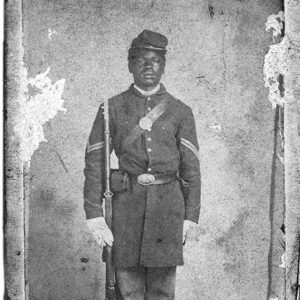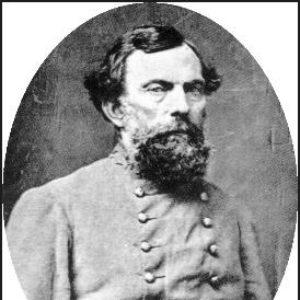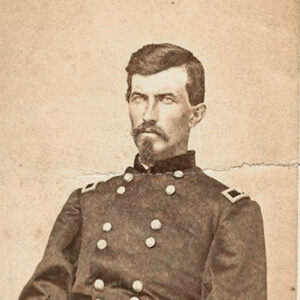calsfoundation@cals.org
Second Arkansas Infantry (African Descent) (US)
aka: Fifty-fourth U.S. Colored Infantry
The Second Arkansas Infantry (African Descent) was one of the many African-American units formed following the Emancipation Proclamation. The regiment was raised under the commands of Lieutenant Colonel George W. De Costa and Major George W. Burchard in early 1863 and was composed primarily of freed slaves in the Arkansas River Valley. Before the unit could officially report for muster as part of the District of Eastern Arkansas, it found itself engaged in the Battle of Helena.
On the morning of July 4, 1863, Confederate forces under the command of Lieutenant General Theophilus Holmes organized a three-pronged attack on the fortified Union position at Helena (Phillips County). The attack would ultimately fail, securing eastern Arkansas as a Union supply stronghold along the Mississippi River. During the course of the battle, the Second Arkansas was ordered in position to cover the left flank of the Federal line. While the regiment was not directly engaged in the fighting—and the battle was overshadowed by actions in both Vicksburg, Mississippi, and Gettysburg, Pennsylvania, on the same day—news of their action received attention throughout the North as a means of gaining support for the abolitionist movement.
Following the repulse of Holmes’s attack, the Second Arkansas was formally mustered in on September 4, 1863. The regiment was attached to the Department of Arkansas, Seventh Corps, Frontier Division Second Brigade. The regiment spent that winter posted in Little Rock (Pulaski County) as part of the city’s garrison.
On March 11, 1864, the regiment received a new designation as the Fifty-fourth U.S. Colored Infantry Regiment. Following the change, the unit marched back to Helena and undertook duty around the supply depot there. The regiment remained stationed in Helena through May 1864 until being ordered into Indian Territory that summer. The Fifty-fourth took up station in Fort Gibson (located in present-day Oklahoma), a staging area for southbound Union troops.
Following the bolstering of the earthwork defenses around Fort Gibson, the regiment was engaged in the Second Battle of Cabin Creek on September 19, 1864. Confederate forces under the command of Brigadier Generals Richard Montgomery Gano and Stand Watie surprised a Federal supply convoy under the protection of the Second Kansas Cavalry. Rebel forces formed their battle line around the Cabin Creek stockade and seized approximately 130 wagons of the 300-wagon supply train. Reinforcements under Colonel James M. Williams of the Frontier Division Second Brigade, including the Fifty-fourth, marched from Fort Gibson to recapture the lost convoy wagons. The Federal infantry engaged the Confederates at Pryor’s Creek, but as the sun set the Rebels were able to escape with the supplies under cover of darkness. The battle is remembered as the last major engagement of the Civil War in Indian Territory, and it is estimated that more than $1.5 million in supplies were lost.
With the Confederate victory at Cabin Creek, the Fifty-fourth was ordered north to escort refugee and supply trains moving into Kansas from Arkansas. Confederate guerrillas raided several wagon trains along Cow Creek in November of 1864, capturing supplies and routing Kansas cavalry detachments. With the skirmishes proving a hindrance to Union supplies in the west, the Fifty-fourth was ordered to patrol Cow Creek from November 14 through November 28, staving off Rebel skirmishers and ensuring the safe arrival of convoys bound for Fort Leavenworth, Kansas.
The Fifty-fourth was next moved south to guard against raiders along the Arkansas River. Rebel forces had been active along the river for a number of months, including an August 17 raid that resulted in the capture and burning of the Federal steamer Miller. On December 18, the Fifty-fourth engaged Rebel skirmishers along the Arkansas River and drove them from the area. The regiment would again see action along the Arkansas River on January 18, 1865, once more successfully driving Rebel forces from the banks of the river. As the war drew toward a close, the Fifty-fourth would continue to search for Confederate raiders along the Arkansas waterways, successfully engaging one of the last remaining bands of guerrillas at the Saline River in a series of running skirmishes in the spring of 1865.
With the surrender of the Confederate army at Appomattox Court House on April 9, 1865, and the subsequent surrender of Rebel troops as word spread west, the Fifty-fourth was stationed in Little Rock as part of a garrison force to oversee the end of guerrilla fighting and to aid in reconstruction. The regiment continued regular duty in the Little Rock area through 1866, until being mustered out between August 8 and December 31, 1866.
For additional information:
Burton, Arthur T. Black, Buckskin, and Blue: African-American Scouts and Soldiers on the Western Frontier. New York: Eakin Press, 1999.
Chaplain Asa B. Randall Civil War Report. Butler Center for Arkansas Studies, Little Rock, Arkansas.
Glatthaar, Joseph T. Forged in Battle: The Civil War Alliance of Black Soldiers and White Officers. Baton Rouge: Louisiana State University Press, 2000.
Jefferson Robinson Civil War Diary. Butler Center for Arkansas Studies, Little Rock, Arkansas.
Wilson, Joseph T. The Black Phalanx: African American Soldiers in the War of Independence, the War of 1812, and the Civil War. New York: De Capo Press, 1994.
Donald Lewis
Lee’s Summit, Missouri
 Black Union Troops
Black Union Troops Military
Military Napoleon Expedition
Napoleon Expedition War of 1812
War of 1812 Aaron Brooks
Aaron Brooks  Theophilus Holmes
Theophilus Holmes  James M. Williams
James M. Williams 




Comments
No comments on this entry yet.